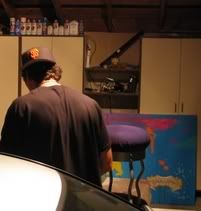Good story from the SF Chronicle website by Simone Sebastian.
***
Hip-hop trends spread to suburbia
Lyrics, dance moves too explicit for some parents
by, Simone Sebastian
Don't let 7-year-old Nicholas Johnstone's blond hair, green eyes and middle-class upbringing fool you. This Berkeleyite may be from the 'burbs, but shorty can bust a rhyme and knows a hot track when he hears one.
Raised near the base of the Berkeley hills, Nicholas' favorite artist is rapper 50 Cent. The first-grader makes up his own lyrics, raps along with hip-hop radio and even mimics the limp walk fashioned by early rappers.
His parents introduced him to classical and jazz music as a toddler. But from his first day of kindergarten, Nicholas started using slang that his parents knew he didn't learn at home.
"I personally am having a problem with things my first-grader is coming home with. Things I can't relate to," said Nicholas' mother, Gail Martin, who has started listening to and reading articles about hip hop to better understand her son's tastes. "He always wants to listen to rap and no other type of music."
From X-rated lyrics on the playground to freak dancing at the prom, hip-hop culture has infiltrated schools at every grade and in every neighborhood.
Northern California suburban schools are increasingly clamping down on the most controversial elements of the trend, drawing a mixture of applause and resistance from students and parents.
Some school administrators have added grills -- metal caps worn over the teeth that rappers popularized as a symbol of wealth -- to their lists of illicit preteen and adolescent attire. Since September, more than a half-dozen suburban Bay Area schools have adopted or started drafting policies that ban freak dancing -- grinding in sexually explicit positions, typically with the girl's back to the boy's front -- from school-sponsored events.
Administrators say the trend is not an assault on hip-hop, but an effort to traverse the thin line between students' freedom of expression and their parents' standards of appropriateness.
"It's a bigger deal because it's happening at the schools where you don't expect to see it," Miguel Fonseca, known as DJ Hightop on the Bay Area school dance circuit.
Fonseca, 36, said he's seen schools take increasingly strict stances on explicit hip-hop dancing styles. At a recent school dance in rural Amador County, he said, administrators eliminated from his playlist most songs that included the word "back" -- slang for a woman's buttocks -- in the title, from Sir Mix-A-Lot's decade-and-half-old "Baby Got Back" to the modern club hit "Lean Back" by the Terror Squad.
"That one killed me," Fonseca said, noting that those songs are frequent requests by pre-adolescents and teenagers. "Hip-hop is becoming their culture."
Last month, Montgomery High School in Santa Rosa began requiring students and their parents to sign a form prohibiting "intimate touching, sexual squatting or sexual bending" during school dances.
At the first dance under the new policy, student attendance dropped by half, said Principal Bill Stirnus. Students at Montgomery, as well as some other schools where freak dancing has been banned, say the style is the only dancing they know.
"It's unfortunate that kids don't have a wider variety. In my day, slow songs were more sexual," said Stirnus, 58. "Today, the hip-hop is more sexual and during the slow songs, students walk off the dance floor."
In the interest of intergenerational solidarity, some schools have formed hip-hop clubs in which members perform choreographed dances or freestyle rap under adult supervision.
One such school is Carlmont High in Belmont, which five years ago became one of the first campuses in the Bay Area to ban freak dancing. Andrea Jenoff, the school's principal, said she still suspends about three couples every dance for doing hip-hop bump-and-grinds.
Carlmont has an all-girl hip-hop dance squad, a club that performs at school assemblies. But it's tame stuff and "very cute," Jenoff said.
Meanwhile, students as young as 6 are showing off their hip-hop moves on the playground at Cragmont Elementary School in Berkeley, which offers an after-school dance class.
Coordinator Angela Gilder said that the class has become so popular that parents from other schools have asked to enroll their children. She doesn't know the names of the artists whose music the students dance to, but she closely monitors their lyrics to make sure it's age-appropriate.
"I want to make sure the students aren't exposed to a negative type of attitude," she said. The class "was brought in to provide a positive form of expression. It's a type of exercise, and the kids have a lot of fun doing it."
The hip-hop club at Berkeley's Alternative High School, where students learn how to DJ and freestyle rap, provides entertainment during lunchtime.
Principal Victor Diaz stressed that the club members study "old-school hip hop," heavy on the culture and light on the profanity.
"They don't use it as a tool to degrade women, (promote) materialism, or repp'ing a terhttp://www.blogger.com/img/gl.link.gifritory," he said. "The true essence (of hip-hop) is about cultural pride, self-respect and coming together."
Peter Johnstone, 7-year-old Nicholas' father, said he hopes he can draw his son into that positive side of hip-hop before he becomes too influenced by the more objectionable version popular right now.
For the past two summers, Nicholas has taken hip-hop dance classes at the Jewish Community Center, and sometimes, to broaden his horizons from 50 Cent, his father will play 1980s and 1990s albums from such hip-hoppers as Public Enemy and Grandmaster Flash.
"Saying no (to hip hop) completely is a mistake," Peter Johnstone said. "The suburban kids like the sound of it, but they also like that it makes their parents nervous."
***
There are
Subscribe to:
Post Comments (Atom)

No comments:
Post a Comment